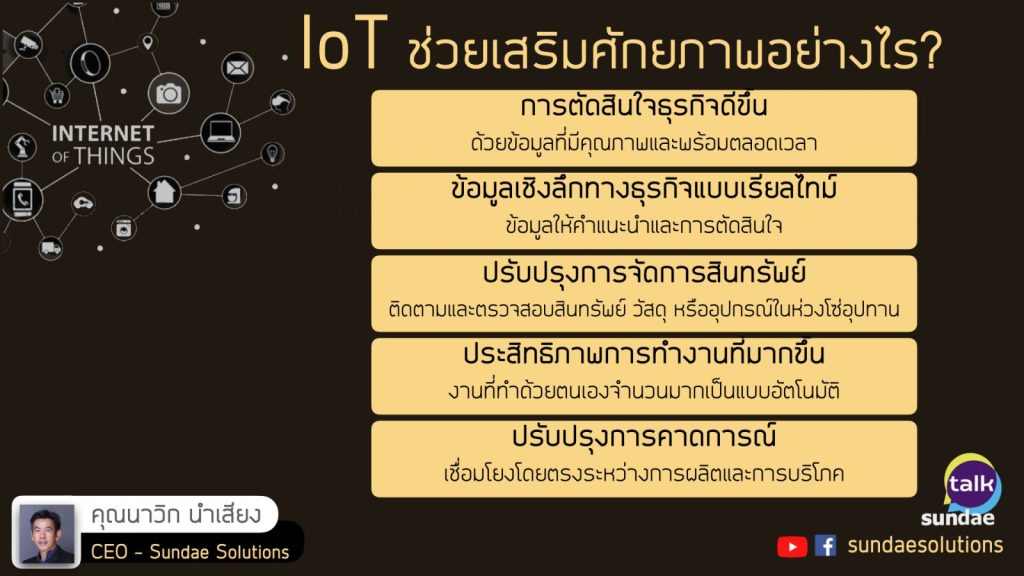Empower ERP with IoT (Internet of Thing) [en]
- October 12, 2021
- Posted by: Siriluck Sukitphittayanon
- Category: Articles-EN


Modern ERP systems seamlessly tie all the business applications together into a consolidated platform, improving data visibility, control, and decision making. However, ERP business processes have remained mostly unchanged from the way they were designed decades ago. But integrating ERP with Internet of Things (IoT) can be highly beneficial – for both back-office as well as customer-facing processes.
The Internet of Things (IoT) refers to a network of objects, devices, vehicles, buildings and other objects embedded with electronic circuits, software, sensors, and network connections, and enabling those objects to store, record, and exchange information. The Internet of Things allows objects to be aware of their surroundings and be controlled remotely through existing network infrastructure. It allows us to more closely integrate the physical world with the computer system. The result is increased efficiency, accuracy and economic benefits.
IoT solutions allow for data sharing in real-time from all kinds of external machines and devices back into the internal ERP systems. Organizations no longer need to struggle to connect their internal business applications and processes to the external data. Data collection from these IoT devices happens in real time and is highly accurate, increasing the chances of gaining actionable insights.

What are the Benefits of Integrating ERP with IoT?
#1 Better Decision Making Due to Improved Data Quality and Availability
Gartner estimates that by 2020, over 26 billion IoT devices will be connected to the internet. This means the amount of data available to companies is growing rapidly and many companies collecting this data aren’t prepared for the challenges involved in handling big data. Successful digital transformation requires actionable insights, which depends on the quality and quantity of the data collected by IoT devices. By integrating their ERP with IoT, they can improve data quality and availability, ensuring that any changes in asset health and utilization is directly reflected in the ERP system in real-time. All the concerned personnel will be notified of these events, enabling them to use this vital information to take immediate action as required.
#2 Real-Time Business Insights
Integrating ERP with IoT data helps organizations to gain vital business insights instantaneously. The continuous stream of data from IoT sensors and devices allows businesses to perform real-time analysis, helping them gain actionable insights to improve decision making. These actionable insights from IoT data have the potential to transform your operations from a reactive to a proactive approach. You can also consider integrating ERP systems with AI and ML along with IoT so that employees get the right suggestions at the right time, helping them make the right decisions.
#3 Improved Asset Management
IoT can provide real-time information by tracking and monitoring high-value assets, materials or equipment in the supply chain. Integrating ERP with IoT automatically feeds this information into the ERP system so that all parties involved in the supply chain can stay informed and take action accordingly. IoT solutions can also warn relevant employees by sending notifications when assets need attention (repairs/breakdowns) or when they are vulnerable to theft or damage.
#4 Greater Operational Efficiency
Operational efficiency can be improved as many manual tasks are automated by integrating ERP with IoT technology – for instance, no human effort will be required to scan a barcode and input the data manually into the ERP system. With IoT, all activities like reordering, restocking, inventory updates, and missed deliveries can all be tracked and automatically updated in your ERP system in real time with sensors embedded in machines and parts.
#5 Improved Forecasting
Forecasting consumer purchases and usage of a product is a complex process and creates huge problems when companies get it wrong. It is easier to make better supply chain decisions by analyzing massive quantities of IoT data. Integrating ERP with IoT establishes a direct link between production and consumption by enabling businesses to capture real-time data, directly from consumers and sending it to their ERP systems. You can capture information about when products are being used, the demographics of your consumers, and the frequency of use, all of which makes forecasting and planning easier and more effective.

